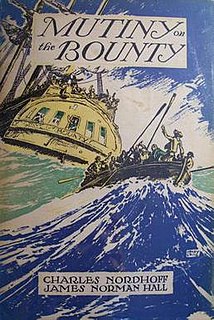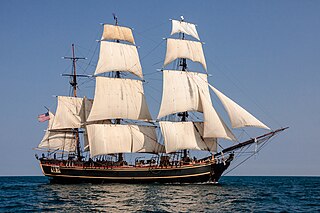
Vice-Admiral William Bligh was an officer of the Royal Navy and a colonial administrator. The Mutiny on the Bounty occurred during his command of HMS Bounty in 1789; after being set adrift in Bounty's launch by the mutineers, Bligh and his loyal men all reached Timor alive, after a journey of 3,618 nautical miles.

Mutiny on the Bounty is the title of the 1932 novel by Charles Nordhoff and James Norman Hall, based on the mutiny against Lieutenant William Bligh, commanding officer of the Bounty in 1789. It has been made into several films and a musical. It was the first of what became The Bounty Trilogy, which continues with Men Against the Sea, and concludes with Pitcairn's Island.

The mutiny on the Royal Navy vessel HMS Bounty occurred in the south Pacific on 28 April 1789. Disaffected crewmen, led by Acting Lieutenant Fletcher Christian, seized control of the ship from their captain, Lieutenant William Bligh, and set him and 18 loyalists adrift in the ship's open launch. The mutineers variously settled on Tahiti or on Pitcairn Island. Bligh meanwhile completed a voyage of more than 3,500 nautical miles in the launch to reach safety, and began the process of bringing the mutineers to justice.

The Bounty is a 1984 British historical drama film directed by Roger Donaldson, starring Mel Gibson and Anthony Hopkins, and produced by Bernard Williams with Dino De Laurentiis as executive producer. It is the fifth film version of the story of the mutiny on the Bounty. The film also features Laurence Olivier, Daniel Day-Lewis and Liam Neeson.

Fletcher Christian was master's mate on board HMS Bounty during Lieutenant William Bligh's voyage to Tahiti during 1787–1789 for breadfruit plants. In the mutiny on the Bounty, Christian seized command of the ship from Bligh on 28 April 1789.
Edward "Ned" Young, was a British sailor, mutineer from the famous HMS Bounty incident, and co-founder of the mutineers' Pitcairn Island settlement.

Peter Heywood was a British naval officer who was on board HMS Bounty during the mutiny of 28 April 1789. He was later captured in Tahiti, tried and condemned to death as a mutineer, but subsequently pardoned. He resumed his naval career and eventually retired with the rank of post-captain, after 29 years of honourable service.
Commander Thomas Hayward (1767–1798?) was a British sailor who was present during the Mutiny on the Bounty. He was born in Hackney, where his father, Francis Hayward M.D., was a noted physician.
Admiral Edward Edwards (1742–1815) was a British naval officer best known as the captain of HMS Pandora, the frigate which the Admiralty sent to the South Pacific in pursuit of the Bounty mutineers.

Mutiny on the Bounty is a 1935 Metro-Goldwyn-Mayer drama film directed by Frank Lloyd and starring Charles Laughton and Clark Gable, based on the 1932 Charles Nordhoff and James Norman Hall novel Mutiny on the Bounty.

Mutiny on the Bounty is a 1962 American Technicolor epic historical drama film released by Metro-Goldwyn-Mayer, directed by Lewis Milestone and starring Marlon Brando, Trevor Howard and Richard Harris. The screenplay was written by Charles Lederer, based on the novel Mutiny on the Bounty by Charles Nordhoff and James Norman Hall. Bronisław Kaper composed the score.
James Morrison (1760–1807) was a British seaman and mutineer who took part in the Mutiny on the Bounty.

Men Against the Sea is the second installment in the trilogy by Charles Nordhoff and James Norman Hall about the mutiny aboard HMS Bounty. It is preceded by Mutiny on the "Bounty" and followed by Pitcairn's Island. The novel first appeared in serial form in The Saturday Evening Post hence the copyright date of 1933, and it was first printed in hardcover in January 1934 by Little, Brown and Company.

HMS Bounty, also known as HM Armed Vessel Bounty, was a small merchant vessel that the Royal Navy purchased for a botanical mission. The ship was sent to the Pacific Ocean under the command of William Bligh to acquire breadfruit plants and transport them to the West Indies. That mission was never completed owing to a mutiny led by acting lieutenant Fletcher Christian. This incident is now popularly known as the mutiny on the Bounty. The mutineers later burned Bounty while she was moored at Pitcairn Island. An American adventurer rediscovered the remains of the Bounty in 1957; various parts of it have been salvaged since then.
Thomas Ellison was an able seaman on His Majesty's Armed Ship Bounty. After participating in the Mutiny on the Bounty on 28 April 1789, he remained in Tahiti rather than continuing on to the Pitcairn Islands with the inner core of the mutineers, and in 1791 voluntarily turned himself in to the seamen of HMS Pandora to face justice in England. He was court-martialed at Spithead in September 1792, sentenced to death, and hanged on 29 October. Questions continue as to the degree of Ellison's culpability in the mutiny.
William Muspratt (1759–1797) was an able seaman (AB) on His Majesty's Armed Ship Bounty. After participating in the Mutiny on the Bounty on 28 April 1789, he was court-martialed at Spithead in September 1792, sentenced to death, but escaped the hangman's noose after his conviction was overturned on appeal. He returned to active service in the British navy, and likely perished in 1797 aboard HMS Bellerophon.
John Bligh CB was an officer in the Royal Navy who served during the American War of Independence and the French Revolutionary and Napoleonic Wars.

The complement of HMS Bounty, the Royal Navy ship on which a historic mutiny occurred in the south Pacific on 28 April 1789, comprised 46 men on its departure from England in December 1787 and 44 at the time of the mutiny, including her commander Lieutenant William Bligh. All but two of those aboard were Royal Navy personnel; the exceptions were two civilian botanists engaged to supervise the breadfruit plants Bounty was tasked to take from Tahiti to the West Indies. Of the 44 aboard at the time of the mutiny, 19 were set adrift in the ship's launch, while 25, a mixture of mutineers and detainees, remained on board under Fletcher Christian. Bligh led his loyalists 3,500 nautical miles to safety in the open boat, and ultimately back to England. The mutineers divided—most settled on Tahiti, where they were captured by HMS Pandora in 1791 and returned to England for trial, while Christian and eight others evaded discovery on Pitcairn Island.
Charles Churchill (1759–1790) was the master at arms on board HMAV Bounty during Lieutenant William Bligh's voyage to Tahiti to transplant breadfruit to the British colonies in the West Indies. During a mutiny on the ship, Acting Lieutenant Fletcher Christian seized command of the ship from Bligh on 28 April 1789. Churchill was an active member of the mutiny, being a member of Fletcher Christian's loyalists that arrested Bligh in his cabin.
William Peckover was a gunner in the Royal Navy and served on several vessels most notably commanded by James Cook and William Bligh.











